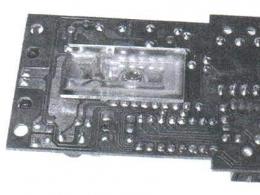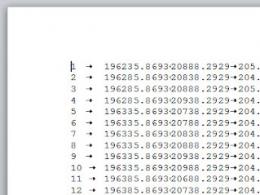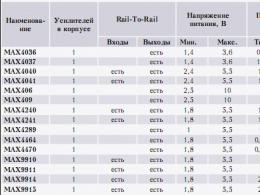Calculation by the method of equivalent transformations. Schematic conversion method
Unbranched electrical circuit characterized by the fact that the same current flows in all its sections, and the branched one contains one or more node points, while different currents flow in sections of the circuit.
When calculating unbranched and branched linear electrical circuits direct current Various methods can be used, the choice of which depends on the type of electrical circuit.
When calculating complex electrical circuits, in many cases it is advisable to simplify them by folding, replacing individual sections of the circuit with series, parallel and mixed resistance connections with one equivalent resistance using the method equivalent transformations electrical circuits.
Rice. 1.1 Fig.1.2
Electric circuit with series connection of resistances
(Fig. 1.1) is replaced by a circuit with one equivalent resistance R eq (Fig. 1.2), equal to the sum of all circuit resistances:

Where R 1, R 2, R 3,…, R n - resistance of individual sections of the circuit. In this case, the current I electrical circuit remains unchanged, all resistances are flown by the same current. The voltages (voltage drops) across the resistances when connected in series are distributed proportionally to the resistances of the individual sections:
![]()
Rice. 1.3 Fig. 1.4
When connecting resistances in parallel, all resistances are under the same voltage U (Fig. 1.3). It is advisable to replace an electrical circuit consisting of parallel-connected resistances with a circuit with an equivalent resistance R eq (Fig. 1.2), which is determined from the expression:
the inverse resistances of sections of parallel branches of the electrical circuit (the sum of the conductivities of the circuit branches); R to − resistance of the parallel section of the circuit; q eq − equivalent conductivity of a parallel section of the circuit,
n– number of parallel branches of the chain. Equivalent resistance of a section of a circuit consisting of identical parallel-connected resistances, When two resistances are connected in parallel R 1
And R 2
equivalent resistance ![]()
and the currents are distributed inversely proportional to their resistances, while U = R 1 I 1 = R 2 I 2 = R 3 I 3 =...= R n I n .
With a mixed connection of resistances (Fig. 1.4), i.e. in the presence of sections of the electrical circuit with serial and parallel
connection of resistances, equivalent resistance (Fig. 1.2) of the circuit
is determined according to the expression:
Literature. GOST R 52002 – 2003; With. 15 – 18, 22 – 26;
With. 14 – 17; With. 18 – 23, 25 – 29.
Example solution
Determine the total equivalent resistance R eq and distribution of currents in a direct current electrical circuit (Fig. 1.5). Resistor values R 1 =R 2 =1 Ohm; R 3 =6 Ohm; R 5 =R 6 =1 Ohm; R 4 =R 7 =6 Ohm; R 8 =10 Ohm; R 9 =5 Ohm; R 10 =10 Ohm. Supply voltage U=120 V.
Solution. Resistance of the circuit section between nodes 1 And 4 :
1" And 3 chains:
Resistance of the section between nodes 1"" And 2 chains:
Equivalent resistance of the entire electrical circuit:
Current in the unbranched electrical part of the circuit:
![]()
Voltage between nodes 1 And 2 chains according to Kirchhoff's II law.
METHOD OF EQUIVALENT TRANSFORMATIONS
In many cases of analysis of complex EC, it becomes necessary to transform the circuit in order to simplify it, i.e. reducing the number of circuit elements. A transformation is considered equivalent if it does not change the currents and voltages in the unconverted part of the circuit. At the same time, changing the topology of the EC does not change its properties. Note that not only the types of elements, but also the topology of their combination determine the properties of the EC.
3.1. Any current source (Fig. 1.2 b) can be replaced by an equivalent voltage source (Fig. 1.2a) and vice versa. In this case, a current source equivalent to a voltage source must generate a current equal to the current short circuit voltage source, and have a parallel internal resistance equal to the series internal resistance voltage source, i.e. circuits are equivalent if
or .
For example, after replacing the current source with a voltage source (Fig. 1.3), in the generalized branch the latter will look like this:
Where . Please note that the direction of the equivalent EMF source coincides with the voltage of the current source. It will be shown below that this section of the chain can be simplified, as shown in Fig. (3.2), where .
3.2. The series connection of resistors during equivalent replacement is summed up:
where is the number of resistors connected in series. At this connection there is always more of the greater of the resistances. In the particular case, if each of the resistances is equal , That .
Example. Determine the equivalent circuit resistance at the terminals.
Here, because there is an open circuit between points and has an infinitely large resistance.
3.3. When connecting resistors in parallel, their conductivity is summed up, where is the number of resistors connected in parallel, and . In a parallel connection, the smaller resistance is always less. In a particular case, if each of the resistances is equal to , then . In the case of two parallel connected resistances and:
Example. Determine on the clamps.
Here, because short circuit resistance is zero.
CALCULATION FORMULAS
3.4. With a mixed connection of resistors, the equivalent resistance of the circuit is determined by sequentially simplifying the circuit and “collapsing” it to one resistance equal to . When calculating currents in individual branches, the EC is “unfolded” in the reverse order.
Example. Determine relative to clamps.
In the last example, the resistance is short-circuited, and the resistances , , have only one common point with the circuit and are therefore not taken into account. Resistances and are connected in series and their equivalent resistance , and are connected in parallel, therefore:
3.5. Converting a passive resistance triangle into an equivalent three-pointed star. The circuits will be equivalent if the resistances between nodes and , and , and in both star and delta circuits are the same:
Solving these equations together, we get:
Reverse conversion three-pointed star into triangle:
Example. Determine the equivalent resistance of the EC relative to the terminals.
First, we transform the resistance triangle, , into an equivalent three-pointed star, ,; then we transform the series-connected resistors , and , , whose equivalent resistances are connected to each other in parallel and can be replaced by one:
The resistor is connected in parallel with resistors and connected to each other in series. Therefore, the equivalent resistance of the entire EC relative to the terminals is:
3.6. Conversion of branches containing serial and parallel connections of emf and current sources.
or two parallel branches with the same conductivity and current source:
RULE OF SIGNS. The terms , are taken with a plus if the direction of the EMF coincides and , if they do not coincide - with a minus.
Example . Convert a circuit with parallel branches containing emf sources into an equivalent one.
Where):
Using this we find the currents on the resistors and ( and ):
The remaining currents can be found using the ZTK for the original circuit.
2. Circuit transformation (convolution) method
If the electrical circuit diagram contains only one energy source ( E or J), then the passive part of the circuit can be transformed (collapsed) to one equivalent element R E (Fig. 7).
Convolution of the circuit begins with the branches furthest from the source and is carried out in several stages until complete convolution is achieved. After complete convolution of the circuit, the source current is determined according to Ohm's law: . The currents in the remaining elements of the original circuit are in the process of reverse sweep of the circuit. This method of calculating currents is called the method of sequential transformation (convolution) of the circuit.
When using this method The following types of transformations are possible.
1) Serial conversion consists of replacing several elements connected in series with one equivalent one (Fig. 8). It is easy to prove that the following relations are valid: ![]() And
And

2) Parallel conversion consists of replacing several elements connected in parallel with one equivalent one (Fig. 9). It is easy to prove that the following relations are valid:  And
And 
For two elements:  And
And ![]()

3) Mutual conversion of star schemes-triangle(Fig. 10) occurs when convolving complex circuits.
The condition for the equivalence of two circuits is that their currents are equal ( I 1, I 2, I 3), voltage ( U 12, U 23, U 31) and input resistances ( R 12, R 23, R 31) and, accordingly, input conductivities ( G 12, G 23, G 31).
Let us equate the input resistances for both circuits on the side of two arbitrary branches with the third one disconnected (Fig. 10):
 (1)
(1) (2)
(2) (3)
(3)

Let's add equations (1) and (3) term by term and subtract equation (2) from the sum, we get:  , Similarly:
, Similarly:  ,
,  .
.
Let us equate the input conductivities for both circuits from the side of an arbitrary vertex and two other short-circuited vertices (Fig. 11):  (4)
(4) (5)
(5) (6)
(6)
Let's add equations (4) and (5) term by term and subtract equation (6), we get:  , Similarly:
, Similarly:  ,
,  .
.
In the last equations, we replace the conductivities with the corresponding resistances, we get:  ;
;  ;
;  .
.

In the presence of complete symmetry, the relationship between the parameters of equivalent circuits is:.
4) Replacing parallel branches with an equivalent branch(Fig. 12) is carried out in accordance with the equivalent generator theorem.
An electrical circuit with a series connection of resistances (Figure 1.3, a) is replaced by a circuit with one equivalent resistance Rek (Figure 1.3, b), equal to the sum of all resistances of the circuit:
Rek = R1 + R2 +…+ Rn = , (1.5)
where R1, R2…Rn are the resistances of individual sections of the circuit.

Figure 1.3 Electrical circuit with series connection of resistances
In this case, the current I in the electrical circuit remains unchanged, all resistances are flown by the same current. The voltages (voltage drops) across the resistances when connected in series are distributed proportionally to the resistances of the individual sections:
U1/R1 = U2/R2 = … = Un/Rn.
When connecting resistances in parallel, all resistances are under the same voltage U (Figure 1.4). It is advisable to replace an electrical circuit consisting of parallel-connected resistances with a circuit with an equivalent resistance Rek, which is determined from the expression
where is the sum of the reciprocal values of the resistances of sections of parallel branches of the electrical circuit;
Rj is the resistance of the parallel section of the circuit;
n is the number of parallel branches of the chain.

Figure 1.4 Electrical circuit with parallel connection of resistances
The equivalent resistance of a section of a circuit consisting of identical resistances connected in parallel is equal to Rek = Rj/n. When two resistances R1 and R2 are connected in parallel, the equivalent resistance is determined as
and the currents are distributed inversely proportional to these resistances, while
U = R1I1 = R2I2 = … = RnIn.
With a mixed connection of resistances, i.e. in the presence of sections of an electrical circuit with series and parallel connection of resistances, the equivalent resistance of the circuit is determined in accordance with the expression

In many cases, it also turns out to be advisable to convert resistances connected by a triangle (Figure 1.5) to an equivalent star (Figure 1.5).

Figure 1.5 Electrical circuit with delta and star connection of resistances
In this case, the resistance of the rays of the equivalent star is determined by the formulas:



R1 = ; R2 = ; R3 = ,
where R1, R2, R3 are the resistances of the rays of the equivalent resistance star;
R12, R23, R31 - resistances of the sides of the equivalent resistance triangle. When replacing the resistance star with an equivalent resistance triangle, its resistance is calculated using the formulas:
R31 = R3 + R1 + R3R1/R2; R12 = R1 + R2 + R1R2/R3; R23 = R2 + R3 + R2R3/R1.
If an electrical circuit contains several resistors, then to calculate its main parameters (current, voltage, power) it is convenient to replace all resistive devices with one equivalent circuit resistance. Only for it the following requirement must be met: its resistance must be equal to the total value of the resistances of all elements, that is, the readings of the ammeter and voltmeter in the conventional circuit and in the converted one must not change. This approach to solving problems is called the chain folding method.
Attention! The calculation of the equivalent (total or total) resistance in the case of series or parallel connection is performed using different formulas.
Series connection of elements
When serial connection all devices are connected in series with each other, and the assembled circuit has no branches.
With this connection, the current passing through each resistor will be the same, and the total voltage drop is the sum of the total voltage drops across each device.

To determine the total value in this case, we use Ohm’s law, which is written as follows:
From the above expression we get the valueR:
Because with a serial connection:
- I = I1 = I2 =…= IN (2),
- U = U1 + U2 +…+ UN (3),
formula for calculating equivalent resistance (RgenerallyorReq) from (1) – (3) will have the form:
- Req = (U1 + U2 + …+ UN)/I,
- Req = R1 + R2 + … + RN (4).
Thus, if there isNseries connected identical elements, then they can be replaced with one device that has:
Rtot = N R (5).
With this connection, the inputs from all devices are connected at one point, the outputs at another point. These points in physics and electrical engineering are called nodes. On electrical diagrams, nodes represent places where conductors branch and are indicated by dots.

We also calculate the equivalent resistance using Ohm's law.
In this case, the total current is the sum of the currents flowing through each branch, and the voltage drop for each device and the total voltage are the same.
If there areNresistive devices connected in this way, then:
I = I1 + I2 + … + IN (6),
U = U1 = U2 = … = UN (7).
From expressions (1), (6) and (7) we have:
- Rtotal = U/(I1 + I2 + …+ IN),
- 1/Req = 1/R1 + 1/R2 +…+ 1/RN (8).
If availableNidentical resistors having a connection of this type, then formula (8) is transformed as follows:
Rtotal = R · R / N · R = R / N (9).
If several inductors are connected, then their total inductive reactance is calculated in the same way as for resistors.
Calculation for mixed connection of devices
In the case of a mixed connection, there are sections with serial and parallel connections of elements.
When solving the problem, use the chain folding method (method of equivalent transformations). It is used to calculate parameters if there is one energy source.
Let's assume the following problem is given. Electrical diagram(see figure below) consists of 7 resistors. Calculate the currents in all resistors if the following initial data are available:
- R1 = 1 Ohm,
- R2 = 2Ohm,
- R3 = 3Ohm,
- R4 = 6 Ohm,
- R5 = 9 Ohm,
- R6 = 18 Ohm,
- R7 = 2.8 Ohm,
- U = 32V.

From Ohm's law we have:
where R is the total resistance of all devices.
We will find it using the chain folding method.
ElementsR2 AndR3 connected in parallel, so they can be replaced byR2,3 , the value of which can be calculated using the formula:
R2,3= R2·R3 / (R2+R3).
R4 , R5 AndR6 are also connected in parallel and can be replaced byR4,5,6 , which is calculated as follows:
1/R4,5,6 = 1/R4+1/R5+1/R6.
Thus, the circuit shown in the picture above can be replaced with an equivalent one, in which R2,3 and R4,5,6 are used instead of resistors R2, R3 and R4, R5, R6.

According to the picture above, as a result of transformations we get serial connection resistors R1, R2,3, R4,5,6 and R7.
Rgenerallycan be found by the formula:
Rtotal = R1 + R2,3 + R4,5,6 + R7.
Substitute numerical values and calculateRfor certain areas:
- R2.3 = 2Ohm 3Ohm / (2Ohm + 3Ohm) = 1.2Ohm,
- 1/R4,5,6 = 1/6Ohm + 1/9Ohm + 1/18Ohm = 1/3Ohm,
- R4,5,6 = 3 Ohm,
- Req = 1 Ohm + 1.2 Ohm + 3 Ohm + 2.8 Ohm = 8 Ohm.
Now, after we foundReq, you can calculate the valueI:
I = 32V / 8Ohm = 4A.
After we have received the value total current, you can calculate the current flowing in each section.
Because theR1 , R2,3,R4,5,6 AndR7 connected in series, then:
I1 = I2,3 = I4,5,6 = I7 = I = 4A.
- U2.3 = I2.3 R2.3,
- U2.3 = 4A 1.2Ohm = 4.8V.
Since R2 and R3 are connected in parallel, thenU2,3 = U2 = U3 , hence:
- I2 = U2 / R2,
- I2 = 4.8V / 2Ohm = 2.4A,
- I3 = U3 / R3,
- I3 = 4.8V / 3Ohm = 1.6A.
- I2,3 = I2 + I3,
- I2.3 = 2.4A + 1.6A = 4A.
- U4,5,6 = I4,5,6 R4,5,6,
- U4,5,6 = 4A 3Ohm = 12V.
Since R4, R5, Rb are connected in parallel to each other, then:
U4,5,6 = U4 = U5 = U6 = 12V.
We calculateI4, I5, I6:
- I4 = U4 / R4,
- I4 = 12V / 6Ohm = 2A,
- I5 = U5 / R5,
- I5 = 12V / 9Ohm » 1.3A,
- I6 = U6 / R6,
- I5 = 12V / 18Ohm » 0.7A.
Checking the correctness of the solution:
I4,5,6 = 2A + 1.3A + 0.7A = 4A.
To automate the calculations of equivalent values for various sections of the circuit, you can use Internet services that offer on their websites to perform online calculations of the required electrical characteristics. The service usually has a built-in special program– a calculator that helps you quickly calculate the resistance of a circuit of any complexity.
Thus, the use of the equivalent transformation method when calculating mixed compounds various devices allows you to simplify and speed up calculations of basic electrical parameters.
Video






